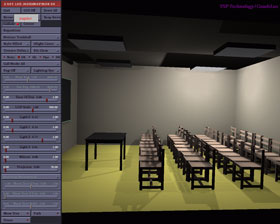|
|||||
Radiosity for Realistic Real-Time Renderingby François Cuny What influences have different surfaces and materials on the impression of the observer? How do different lighting situations influence the perception of architecture or a design? In which areas is additional artificial illumination required? Radiosity and ray tracing are two methods to simulate global lighting effects. Although diffuse inter reflections are crucial to produce realistic images, radiosity-like methods are rarely used in production rendering: slow performance, robustness problems, and control difficulty. VSP Technology succeeded in resolving all the industrial constraints. Founded in 2001, based on research conducted by INRIA, VSP Technology develops and markets a portfolio of lighting simulation software products. With their technologies, it is now possible to physically simulate and render the lighting effect on a 3D scene in real time.
VSP Technology uses wavelet functions in its algorithm in order to resolve the global illumination problem. The use of wavelet functions ensures to have the most accurate approximation of the unknown radiosity function B(x). These recent hierarchical methods combined with a virtual mesh approach have greatly speeded up the computation of radiosity. By carefully designing a parallel algorithm that minimizes synchronization and memory access, VSP Technology was able to obtain speedups of 54 on a 64-processor machine. Also, an important problem is to provide an efficient solution to display the computed radiosity approximation. Both a meshing and a texturing technique give a solution of this problem. VSP Technology uses a texturing technique to store the photometric information. This technique consists in separating lighting information from the geometry by storing the illumination information as a texture map. This is commonly called light map. At the rendering step, this set of textures is blended with the initial geometry to render as accurately as possible the lighting information. Since graphic boards can render up to eight textures in only one pass, this technique is actually opportune and allows 3D interactive manipulation. To ensure that the lighting information is displayed correctly, the mapping process must avoid any overlap off the 3D model. We are unfolding the model using a segmentation method to decompose the model into charts with natural shapes. This method is based on a new optimization-based parameterization method: the least squares conform maps (LSCM). The choice of the LSCM parameterization method is motivated by the properties proved by its author (Levy et al.): Their conformal criterion minimizes angle deformations, which allows often finding a valid parameterization. The parameterization is fast enough to be applied recursively until a valid and low distorted map is found. The natural border extrapolation avoids the distortions implied by the fixed border of other methods. And the result is independent of the resolution of the mesh. This property reduces texture swimming when applied on a multi-resolution structure such as progressive mesh. The result of our wavelet-based radiosity computation is an illumination function from a 2D space (the parameterization space, also called virtual mesh) to a 3D space (colour space) defined on a local normalized mapping of each mesh element. Two main steps drive to the solution:
Then the set of radiosity textures can be mapped on the initial geometry like other existing textures. VSP Technology has applied the generation of radiosity textures to industrial models such as architectural and manufacturer design industries. Our radiosity light maps can easily be integrated into existing rendering software and dramatically increase the realism of a virtual scene without slowing down the rendering speed. Furthermore, we can group light sources together to generate a set of light maps: one light map for each group of light sources. Then, the light maps can be blended together during the rendering step, allowing driving each group of light sources independently. This allows to interact in real-time on the lighting design and to visualize the impact of each light source group in the scene, by controlling independently the intensity of each light group. The implication of this technology is huge: significant reduction of project planning, enormous cost-saving for the visualization of projects, physically accurate simulation results in combination with breathtaking image quality. This aspect of physical accuracy cannot be overemphasized in the domain of design: looks-as-if-real counterfeits obtained by any means - and approach used in video and movies - are hardly acceptable for serious design jobs. Please contact: |
|||||




